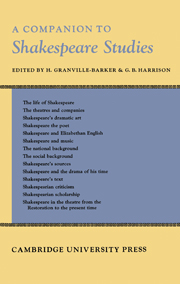Book contents
- Frontmatter
- Contents
- ILLUSTRATIONS
- Preface
- The Life of Shakespeare
- The Theatres and Companies
- Shakespeare's Dramatic Art
- Shakespeare the Poet
- Shakespeare and Elizabethan English
- Shakespeare and Music
- The National Background
- The Social Background
- Shakespeare's Sources
- Shakespeare and the Drama of his Time
- Shakespeare's Text
- Shakespearian Criticism
- Shakespearian Scholarship
- Shakespeare in the Theatre from the Restoration to the Present Time
- Reading List
- Appendices
- Index
- Plate section
Shakespeare in the Theatre from the Restoration to the Present Time
Published online by Cambridge University Press: 05 August 2012
- Frontmatter
- Contents
- ILLUSTRATIONS
- Preface
- The Life of Shakespeare
- The Theatres and Companies
- Shakespeare's Dramatic Art
- Shakespeare the Poet
- Shakespeare and Elizabethan English
- Shakespeare and Music
- The National Background
- The Social Background
- Shakespeare's Sources
- Shakespeare and the Drama of his Time
- Shakespeare's Text
- Shakespearian Criticism
- Shakespearian Scholarship
- Shakespeare in the Theatre from the Restoration to the Present Time
- Reading List
- Appendices
- Index
- Plate section
Summary
Public stage-plays were prohibited by Parliament in September 1642. The prohibition was far from effectual; and one way of getting round it was the performance, under pretence of ropedancing and the like, of ‘drolls’, that is, extracts from plays or abbreviations of plays. Among these may have been the Merry Conceits of Bottom the Weaver, published with others in 1673. But the theatrical events of the Interregnum have little direct bearing on the subsequent history of Shakespeare. The first play by Shakespeare to be acted after (or perhaps just before) the Restoration was apparently Pericles, staged in the spring or summer of 1660 at the Phoenix or Cockpit playhouse in Drury Lane by a company of young players collected by John Rhodes, a bookseller, who had formerly been wardrobe keeper at the Blackfriars Theatre. Of this company Betterton (then, perhaps, twenty-five years old), who had been apprenticed to the bookselling, was a member, and soon a notable one. Another company, chiefly composed of old players of King Charles I's days, was acting at the Red Bull playhouse in Clerkenwell, and a third was set up by William Beeston at the playhouse in Salisbury Court, Whitefriars. Any Shakespeare which these companies acted must have been performed as near as possible in the pre-Rebellion manner–whatever that may have become. The changes came in gradually, and began with a restriction on the freedom of the drama.
- Type
- Chapter
- Information
- Companion to Shakespeare Studies , pp. 325 - 346Publisher: Cambridge University PressPrint publication year: 1934



